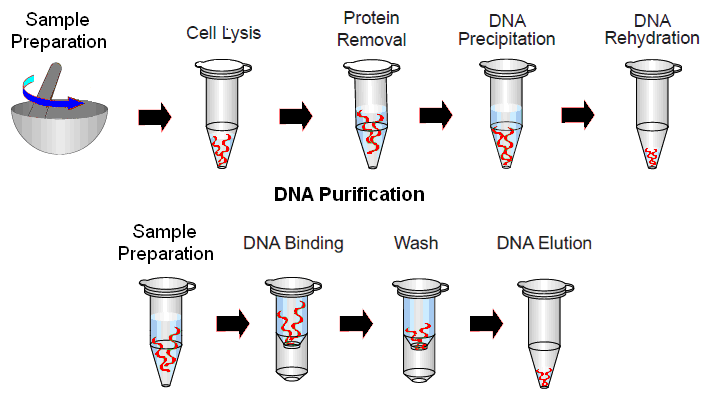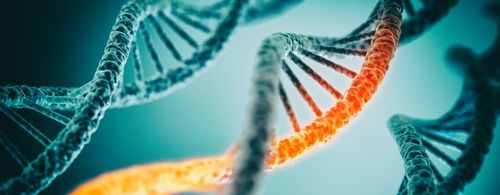The Isolation of Genomic DNA from the bacterium, Escherichia coli is explained in this section
Aim of the experiment: To isolate the genomic DNA from Escherichia coli DH5α cells.
PRINCIPLE OF THE EXPERIMENT
The isolation and purification of DNA from cells is one of the most common procedures in contemporary molecular biology and embodies a transition from cell biology to the molecular biology (from in vivo to in vitro).
The isolation of DNA from bacteria is a relatively simple process. The organism to be used should be grown in a favorable medium at an optimal temperature, and should be harvested in late log to early stationary phase for maximum yield.
The genomic DNA isolation needs to separate total DNA from RNA, protein, lipid, etc. Initially the cell membranes must be disrupted in order to release the DNA in the extraction buffer. SDS (sodium dodecyl sulphate) is used to disrupt the cell membrane. Once cell is disrupted, the endogenous nucleases tend to cause extensive hydrolysis. Nucleases apparently present
on human fingertips are notorious for causing spurious degradation of nucleic acids during purification.
DNA can be protected from endogenous nucleases by chelating Mg2++ ions using EDTA. Mg2++ ion is considered as a necessary cofactor for action of most of the nucleases. Nucleoprotein interactions are disrupted with SDS, phenol or proteinase K. Proteinase enzyme is used to degrade the proteins in the disrupted cell soup. Phenol and chloroform are used to denature and separate proteins from DNA.
Chloroform is also a protein denaturant, which stabilizes the rather unstable boundary between an aqueous phase and pure phenol layer. The denatured proteins form a layer at the interface between the aqueous and the organic phases which are removed by centrifugation. DNA released from disrupted cells is precipitated by cold absolute ethanol or isopropanol.
MATERIALS REQUIRED FOR GENOMIC DNA ISOLATION
- LB broth
- E. coli
- Reagents
- Tris EDTA (TE) buffer
- 10 % SDS
- Proteinase K
- Phenol-chloroform mixture
- 5M sodium acetate (pH 5.2)
- Isopropanol
- 70% ethanol
- Autoclaved distilled water
- Eppendorf tubes (2 ml)
- Micropipettes
- Microtips
- Microfuge
PREPARATION OF REAGENTS FOR GENOMIC DNA ISOLATION
1. TE BUFFER (pH 8.0): 10 mm Tris HCl (pH 8.0), 1 mm EDTA (pH 8.0)
2. 10% SDS: Dissolve 10 g of SDS in 100 ml autoclaved distilled water.
3. PROTEINASE K: Dissolve 10 mg of Proteinase K in 1 ml autoclaved
distilled water.
4. PHENOL – CHLOROFORM MIXTURE: The pH is very important. For RNA purification, the pH is kept around pH 4, which retains RNA in the aqueous phase preferentially. For DNA purification, the pH is usually 7 to 8, at which point all nucleic acids are found in the aqueous phase. Mix equal volume of phenol with chloroform. Keep the mixture on ice and add 20 ml
TE buffer, extract by shaking for 15 minutes. Remove the dust on the surface layer using a pipette. Repeat 4-5 times. Add 30-40 ml of TE buffer and store it on ice.
5. 5M SODIUM ACETATE: Dissolve 41 g of sodium acetate in 100 ml distilled water and adjust pH with dilute acetic acid (pH 5.2).
6. ISOPROPANOL
7. 70% ETHANOL
PROCEDURE FOR CARRYING OUT GENOMIC DNA ISOLATION
- 2 ml overnight culture is taken and the cells are harvested by centrifugation for 10 minutes.
- 875 µl of TE buffer is added to the cell pellet and the cells are resuspended in the buffer by gentle mixing.
- 100 µl of 10% SDS and 5 µl of Proteinase K are added to the cells.
- The above mixture is mixed well and incubated at 37º C for an hour in an incubator.
- 1 ml of phenol-chloroform mixture is added to the contents, mixed well by inverting and incubated at room temperature for 5 minutes.
- The contents are centrifuged at 10,000 rpm for 10 minutes at 4º C.
- The highly viscous jelly like supernatant is collected using cut tips and is transferred to a fresh tube.
- The process is repeated once again with phenol-chloroform mixture and the supernatant is collected in a fresh tube.
- 100 µl of 5M sodium acetate is added to the contents and is mixed gently.
- 2 ml of isopropanol is added and mixed gently by inversion till white strands of DNA precipitates out.
- The contents are centrifuged at 5,000 rpm for 10 minutes.
- The supernatant is removed and 1ml 70% ethanol is added.
- The above contents are centrifuged at 5,000 rpm for 10 minutes.
- After air drying for 5 minutes 200 µl of TE buffer or distilled water is added.
- 10 µl of DNA sample is taken and is diluted to 1 or 2 ml with distilled water.
- The remaining samples are stored for further experiments.
PRECAUTIONS TO OBSERVE WHEN PERFORMING GENOMIC DNA ISOLATION
- Cut tips should be used so that the DNA is not subjected to mechanical disruption.
- Depending on the source of DNA the incubation period of Proteinase K should extended.
- The phenol chloroform extraction should be repeated depending on the source of DNA to obtain pure DNA.
- DNase free plastic wares and reagents should be used.
Results and discussion:
As you deem fit
References:
DEPARTMENT OF BIOTECHNOLOGY, SCHOOL OF BIOENGINEERING, SRM UNIVERSITY
Discover more from #1 Microbiology Resource Hub
Subscribe to get the latest posts to your email.



